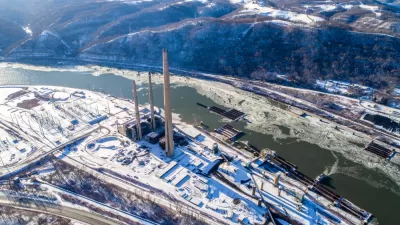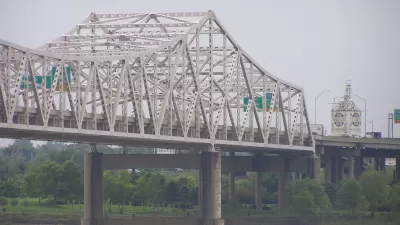The coal industry is pushing legislation to limit the power of the Ohio River Valley Water Sanitation Commission.

The Ohio River Valley Water Sanitation Commission serves eight states. Now its authority to limit pollution in drinking water is under threat. Coal power plants sit along the banks of the Ohio River, and coal companies use the river to move tons of coal on barges. "Electric utilities and other industries are pressing a regional commission to end its role in restricting the dumping of toxic wastewater into the river, arguing there's too much bureaucracy already," James Bruggers reports for Inside Climate News.
The Commission has made serious progress in cleaning up drinking water that serves millions of people. "That progress has allowed riverside cities like Cincinnati and Louisville to rediscover their waterfronts for recreation and tourism—even as significant pollution concerns remain," Bruggers argues.
Coal industry representatives argue that regulations protecting the river from mercury and ash are redundant with other regulations from other government agencies. But Bruggers reports, "There were, as of 2015, 188 instances in which ORSANCO had set a standard for a pollutant that neither a member state nor EPA had set a standard for."
FULL STORY: Industries Try to Strip Power from Ohio River's Water Quality Commission

Planetizen Federal Action Tracker
A weekly monitor of how Trump’s orders and actions are impacting planners and planning in America.

Congressman Proposes Bill to Rename DC Metro “Trump Train”
The Make Autorail Great Again Act would withhold federal funding to the system until the Washington Metropolitan Area Transit Authority (WMATA), rebrands as the Washington Metropolitan Authority for Greater Access (WMAGA).

DARTSpace Platform Streamlines Dallas TOD Application Process
The Dallas transit agency hopes a shorter permitting timeline will boost transit-oriented development around rail stations.

Supreme Court Ruling in Pipeline Case Guts Federal Environmental Law
The decision limits the scope of a federal law that mandates extensive environmental impact reviews of energy, infrastructure, and transportation projects.

Texas State Bills to Defund Dallas Transit Die
DART would have seen a 30% service cut, $230M annual losses had the bills survived.

Bikeshare for the Win: Team Pedals to London Cricket Match, Beats Rivals Stuck in Traffic
While their opponents sat in gridlock, England's national cricket team hopped Lime bikes, riding to a 3-0 victory.
Urban Design for Planners 1: Software Tools
This six-course series explores essential urban design concepts using open source software and equips planners with the tools they need to participate fully in the urban design process.
Planning for Universal Design
Learn the tools for implementing Universal Design in planning regulations.
Roanoke Valley-Alleghany Regional Commission
City of Mt Shasta
City of Camden Redevelopment Agency
City of Astoria
Transportation Research & Education Center (TREC) at Portland State University
US High Speed Rail Association
City of Camden Redevelopment Agency
Municipality of Princeton (NJ)





























